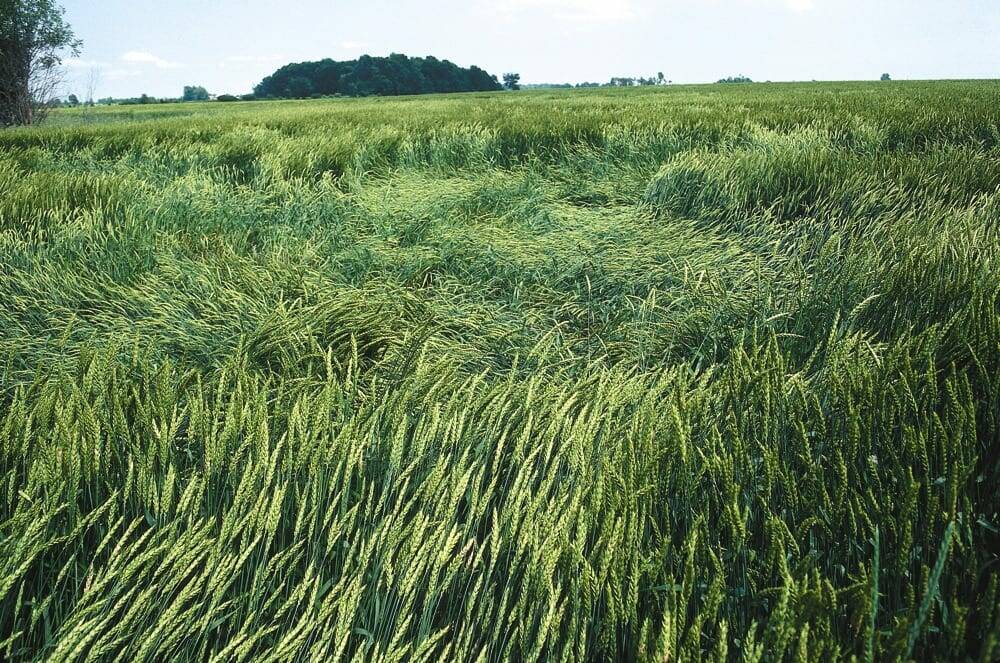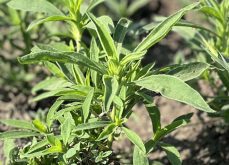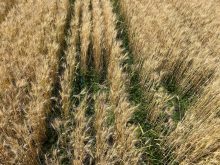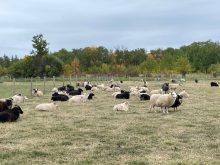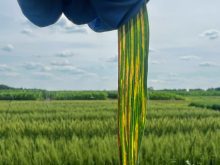Small-grain cereals
In this section we’re referring to wheat, barley, oats, rye and triticale. I have traveled from Quebec to the B.C. lowlands many, many times and in the event of violent wind storms, often during thunderstorms, especially accompanied by heavy rain, crop lodging at close to maturity is expected. You can see the bent or broken stems caused by the force of the wind and weight of the rain. Hail damage is another matter.
Losses in yield and quality from lodging can be high. This kind of weather damage is beyond our control and a good reason for crop insurance. Cereal crop lodging in a good, moist, calm growing season is the problem I will explain, in terms that can be understood. In moist growing seasons, cereal roots remain near the soil surface.
Read Also

Claas brings 1000 Series SP forage harvesters to Canada
In mid-August, Claas unveiled its new line of Jaguar forage harvesters at an event in Visalia, California, deep in the heart of that state’s dairy region.
Minimum-till and zero tillage have, or seem to have, reduced the amount and number of cereal crops I used to see plainly and heavily lodged in early August, particularly across the Prairies, during good growing seasons. There is an explanation — and it is not shorter-stemmed cereal crops or growth regulators.
Why would we have lodging of seemingly well-growing crops during grain formation in good moist growing seasons, in the absence of significant winds, but little or no lodging in dry or drought conditions? Here is the most likely cause — and the only one that seems to elude soil and crop specialists. Soil microbes, or living soil biomass, are the primary culprit.
In good cereal cropland, with around two to five per cent organic levels, are teeming masses of living organisms, especially in mid-summer. In a gram of soil (there are about 28 grams to an ounce) there are 10 billion bacteria or more. These are made up of thousands of bacterial species, all living, multiplying and dying. This soil also includes algae, fungi, protozoa, insects, earthworms and many other microscopic organisms.
These soil organisms have a biomass that could range from 50 to 500 actual grams per square metre (or yard). Now, put this into context: let us say in an average No. 2 Prairie soil with a biomass of 250 grams per square metre or half a pound per square yard approximately, that half-pound per square yard (4,840 square yards an acre) gives you around 2,420 lbs. of bacteria. That is the weight of just about two cows an acre. This mass of two cows is just the bacteria portion. Now, if you add the fungi, insects, worms, nematodes et cetera, you have got another two cow equivalents. So, you now have in good cropland about four cows equivalent per acre chomping on the organic matter in a good healthy moist soil in mid-summer. This “four-cow” mass of soil microorganisms, bugs, fungi and worms wake up as soon as the Prairie soils thaw out and warm up in April of each year.
Now, if this soil is high in crop residue, and particularly if the grower has applied 10-20 tons of cattle manure and worked it into the cropland along with the crop residue, think — this grower has now provided a massive bonanza of organic carbohydrate in the form of crop residue and manure (hog, poultry or cattle) to soil macro and microorganisms. Now the grower sows a wheat crop and also applies the amounts of N, P, K and S needed for a 60-bushel crop of wheat. Then it depends on the crop growing season. Is the soil going to stay warm and moist, or is it going to stay relatively dry all summer?
If the top six to eight inches (15-20 cm) stay relatively dry, the wheat crop will pick up the required N, P, K and S and the roots may move two to four feet (90-120 cm) into the subsoil, the cropland delivers and the target yield of 60 bushels will be attained.
If, on the other hand, it’s a wet summer, the soil bacteria and other microflora and fauna in the top foot or so will just go “hog wild” with the added manure and crop residues. In the form of manure and crop residues, bacteria and associated organisms have all the carbohydrates (food) they need, but in many soils they may be short of nutrients, particularly micronutrients. These micronutrients, particularly copper and zinc, have been removed over 100 years or more in past crop growing seasons.
So, what happens? Were the soil micronutrients “tied up” in the organic residue? Not so — they were just picked up first by the microflora and microfauna, that is, the four cow equivalents or more per acre of soil. Those four cows’ worth of microflora grabbed up all of the already-low soil copper levels in the top eight inches of soil. No copper, no lignin formation, no stem strength — or no pollen formation, then ergots. The lack of copper causes the cereal crops to lodge, with wheat at its most susceptible.
Look up the YouTube video “Lodging Wheat Rescue with Dr. Copper.” There the maturing wheat is growing on roadside soil, low in organic matter and high in available copper. The lodged crop is growing on well-manured soil loaded with actively growing micro-organisms. These organisms have grabbed up the available copper levels that have been drawn down in over 100 years of micronutrient removal.
The wheat, starved of copper, cannot form lignin for stem strength or pollen in some instances for seed set and the wheat heads either have blanks, stray pollen pollination or ergot infection.
If you have any doubts about copper’s importance in organic soils, I will quote this information from Ontario’s Agronomy Guide for Field Crops, page 35: “When black highly organic soils are first brought into cultivation copper should be applied to the soil at 14 kg/ha (12.5 lbs./ac.); that’s 50 lbs. of copper sulphate at 25 per cent copper for each of the first three years.”
Why is it that horticultural specialists are so far ahead of agricultural crop specialists? Such levels of copper are applied to such high-organic matter soils — for example, Brandford Marsh, north of Toronto, or the organic soils of Michigan or Florida. Now, when you manure cropland on the Prairies, I am not suggesting such huge amounts of expensive copper. What I recommend is that if you have cropland prone to lodging, and low yields at the very least, treat a few acres with four to six pounds of actual copper (16-24 lbs. of copper sulphate) and check the results. That level of copper is good for 10-20 years or more. When you get positive results, plan your anti-lodging strategy for your cereal crops — especially wheat and barley — after you have soil-tested for copper levels in particular.
Peas
Peas do not grow on stems but vines, with tendrils that enable them to climb up and over other plants. In nature peas have huge advantages over most competing plants in that they, like other legumes, fix their own nitrogen. When I first grew peas, they were eight-foot climbing vines that grew on six-foot sticks or brushwood in the garden. Ontario in fact had a major industry 150 years ago growing thousands of acres of green peas on rows of canes for export to the U.K.
When I moved to Ontario in 1969, I grew peas in the trial plots and saw them grow six feet tall or more, then collapse on themselves and become heavily rotted. The variety I grew was “Trapper.” Back in 1962 when I visited the U.K. Cambridge Crop Research Station, I remember seeing its prize plots of leafless green peas, which it had obtained via California.
Not until I moved to Alberta in 1974 did I see my first leafless pea crops: all tendrils and few leaves. Pea vines need support, and as a field crop, that support to “stand up” comes from producing more tendrils than leaves, and a shorter stature. The answer to reduce or prevent lodging is following recommended row spacing and seeding heavy-tendril dwarf types that can stand up to windy or rainy weather. These peas may not be the best yielders, but they can be reliable for quality grain. Peas are excellent scavengers of soil-available copper and do not give any response to added copper on mineral soils — probably due to deeper rooting than cereals.
Canola
With the exception of windstorms, lodging in canola is related to seeding density, high fertility and sclerotinia infection. On heavily-manured fertile soils, at high seeding rates of six pounds per acre, and in humid summers, weather lodging can be severe. In soils that are fertilized for target yields in the 50- to 60-bushel range for the canola crop, seeding rates of four to six lbs. seem to be most effective.
Unfortunately, in very highly manured soils, where the soil nitrogen levels may exceed 200 lbs./ac., lighter seeding rates of three to four lbs. or less are recommended. High fertilizer rates (N, P, K, S), particularly of N, encourage very rapid dense canopies under good moisture conditions. These dense canopies at normal seeding rates favour sclerotinia infection in moist weather in July, causing weakened stems and crop lodging. At the higher fertility rates, it may be advisable to reduce seeding rates to three lbs. or even less per acre, to encourage better-standing multiple-branching canola plants less prone to sclerotinia infection and lodging. Canola, with its deeper rooting system of three to four feet, has shown little need for any micronutrient requirement — except perhaps for boron under dry weather conditions.
Flax
At seed set, flax always seems to be on the verge of lodging or sometimes lodged. Our research at Alberta Agriculture in the ’90s showed flax responds very well in many instances to additional zinc and copper micronutrients. Research at a few locations in Alberta on specific sandy-type soils showed significant yield increases when copper in particular was included in the fertilizer inputs. In one instance, upping the N, P, K and S at one central Alberta location, together with a few pounds per acre of both copper and zinc, took an expected flax yields of some 20 bushels to almost 40 bushels an acre. The copper amendment in particular reduces or prevents lodging in flax crops by greatly increasing straw strength.
My father’s opinion: ‘If you are not the lead horse, the scenery never changes.’


